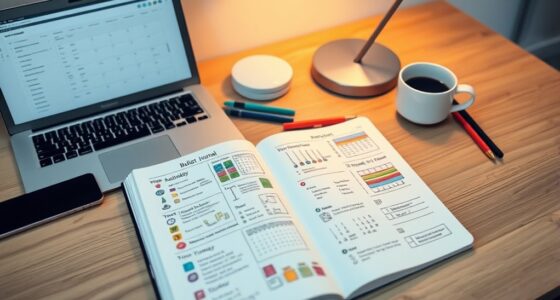Digital minimalism helps you declutter your mind by intentionally simplifying your digital habits. By setting boundaries, limiting notifications, and organizing your digital environment, you reduce distraction and mental overload. It’s about fostering deeper focus, meaningful connections, and a healthier relationship with technology—not rejecting it altogether. This approach promotes well-being and mental clarity. If you keep exploring, you’ll discover practical ways to create a more intentional and fulfilling digital routine.
Key Takeaways
- Practice intentional digital habits by setting specific times for device use and turning off non-essential notifications.
- Declutter your digital environment by unsubscribing from unnecessary emails and deleting unused apps.
- Focus on quality interactions and content, avoiding mindless scrolling and comparison triggers.
- Incorporate mindfulness and breathing exercises to foster mental clarity and emotional balance.
- Establish tech-free zones and periods to promote deeper focus, relaxation, and genuine connections.

Digital minimalism is a deliberate approach to managing your digital life, focusing on reducing clutter and distractions to enhance your well-being. In today’s world, it’s easy to fall into the trap of tech addiction, constantly scrolling through social media, emails, or news feeds. This relentless stream of information can leave you feeling overwhelmed, anxious, and disconnected from the present moment. By embracing digital minimalism, you actively choose what deserves your attention, freeing up mental space and energy for what truly matters.
Digital minimalism helps you take control of your digital life and focus on what truly matters.
One of the most effective ways to start is with a social media detox. Social media platforms are designed to keep you engaged for as long as possible, often at the expense of your mental health. Taking a break allows you to reset your relationship with these platforms, helping you regain control over your time and focus. During a social media detox, you might notice how much mental clutter these apps create—constant notifications, comparison triggers, and the urge to check for updates. Removing or limiting access to social media helps you reclaim your mental clarity and reduces the noise that distracts you from your real-life goals and relationships.
Reducing tech addiction isn’t just about deleting apps; it’s about creating boundaries. Set specific times for checking your devices, turn off non-essential notifications, and consider designating tech-free zones or periods in your day. When you limit your screen time, you prevent digital distractions from hijacking your attention and energy. This intentional approach helps you focus more deeply on tasks, hobbies, or meaningful conversations, rather than constantly reacting to the digital stimuli around you. Incorporating mindfulness practices such as deep breathing exercises can further support your ability to stay present and resist compulsive device use.
Implementing digital minimalism also involves decluttering your digital environment. Organize your inbox, unsubscribe from unnecessary mailing lists, and delete apps or files that no longer serve you. This streamlining process reduces the mental clutter associated with digital overload, making it easier for you to find what matters and stay focused. Over time, this can lead to a more intentional and fulfilling digital routine, where technology serves your needs rather than dictating your mood or productivity.
Ultimately, digital minimalism isn’t about rejecting technology altogether; it’s about fostering a healthier, more mindful relationship with it. By consciously choosing what to engage with, taking social media detoxes when needed, and establishing boundaries, you create space for creativity, relaxation, and genuine connection. This approach helps you declutter your mind, so you can focus on what truly enriches your life, rather than chasing every notification or trending topic. Additionally, integrating practices like sound healing science can support your mental clarity and emotional balance as part of your holistic well-being.
Frequently Asked Questions
How Can Digital Minimalism Improve Mental Health?
Digital minimalism can boost your mental health by helping you focus on what truly matters. When you reduce digital clutter, you create space for mindfulness practices that calm your mind. This clarity enhances your emotional resilience, making it easier to handle stress and setbacks. By simplifying your digital life, you foster a healthier mindset, improve your overall well-being, and develop better emotional control.
What Are the First Steps to Declutter Digital Spaces?
To start decluttering your digital spaces, you should begin with a digital detox, unplugging from devices for a set time. Next, focus on notification management by turning off non-essential alerts to reduce distractions. Delete or organize apps and files you no longer need. This approach helps you regain control, making your digital environment calmer and more intentional, ultimately improving your focus and mental clarity.
Can Digital Minimalism Increase Productivity?
When it comes to digital overload, you’re often fighting a losing battle against information fatigue. Digital minimalism can boost your productivity by helping you focus on what truly matters. By cutting out unnecessary notifications and distractions, you save time and mental energy. It’s like hitting two birds with one stone—reducing stress while increasing efficiency. Embracing digital minimalism allows you to work smarter, not harder, leading to better results and a clearer mind.
How Do You Balance Digital Minimalism With Work Requirements?
To balance digital minimalism with work demands, you should set clear boundaries for your digital use. Schedule regular social media detox periods to stay focused, and streamline your email management by checking emails only at designated times. Use tools to limit distractions and prioritize essential tasks. This way, you stay productive without feeling overwhelmed, maintaining a healthy digital balance that supports both your work and mental well-being.
What Tools Can Assist in Practicing Digital Minimalism?
You can use tools like app blocking to limit access to distracting apps during focused periods, helping you stay on task. Notification management apps enable you to control when and how you receive alerts, reducing interruptions. These tools support your efforts to practice digital minimalism by minimizing digital clutter, allowing you to concentrate better and maintain a clear, calm mind amid your work demands.
Conclusion
By embracing digital minimalism, you clear the clutter from your mind like a spring breeze sweeping through a storm-worn forest. Less screen time means more space for what truly matters, allowing your thoughts to breathe and flourish. Remember, it’s not about cutting out technology entirely, but about wielding it intentionally. When you declutter your digital world, you make room for clarity, creativity, and genuine connection—transforming chaos into calm, one mindful choice at a time.










